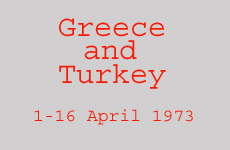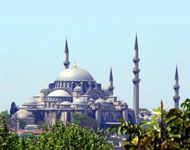|
Page 1 2 3 4 5 6 7 8 9 10 11 12
Friday, 7 April. Today we were leaving Athens to visit the islands of Rhodes and Crete. We took
a taxi to Piraeus where we boarded an overnight ferry to Rhodes which departed in the early
afternoon. We had bought our tickets soon after our arrival in Athens and had reserved and paid
for a cabin. We were confused, though, when we boarded the ferry because it seemed that all the
passengers who boarded with us quickly found places to sit on deck. So we did the same.
After a couple of hours, a crew member came by checking tickets.
When he saw ours, he gestured toward the enclosed area of the ship. Even then,
it took us a while to figure out that none of the other passengers on deck with
us had cabins; they were going to sleep on deck all night. We finally went in
and found our cabin. It was bare-bones and tiny, scarcely larger than its two
bunks and a sink. But it was adequate for a good night’s sleep.
We had also seen the passengers on deck breaking out bags of food and
eating it. Once inside, we saw that the ferry had a passable dining room, and we
ate dinner there. Thank goodness, because we hadn’t packed any food.
Our ferry was scheduled to stop at Mikonos, and we were eager to get a glimpse of that famous
island. However, the sun began to set as we passed Siros. It was dusk (at best) by the time we
reached Mikonos, and we couldn’t see very much or take any pictures. We retired soon after.
Saturday, 8 April. When we awoke in the morning, the ferry was approaching Rhodes Town, the
capitol of the island of Rhodes. We hurried to grab a quick breakfast and get on deck. As we
drew near, the round turret of Agios Nikolaos Castle was the most prominent landmark.
Just beyond it were three old windmills on a narrow breakwater. To the right of
the castle was the entrance to the old harbor (Mandraki) which the Colossus of
Rhodes is said to have straddled.
On disembarking, we took a taxi to the Minos Hotel and checked in. Then as quickly as we could, we set out on foot to explore the waterfront and the old quarter. The town was much like other old Mediterranean towns we’d seen, very picturesque with narrow streets, quaint houses, and pretty gardens.
From its capture in 1522, Rhodes remained a part of the Ottoman Empire until 1912 when it came
under Italian rule. In 1948 it was united with Greece. The entire castle complex, as well as other
parts of the old quarter, were restored by Rhodes’ Italian occupiers in the 1940s and are therefore
in excellent condition (though with a definite Italian flavor). The castle was surrounded by a wide
moat, now completely dry and home to a large number of semi-wild deer (the symbol of Rhodes).
The streets of the old quarter were relatively empty when we began our walk, but once a couple of cruise ships arrived, the area was swarming with people. Socratou Street, where the tourist shops were most concentrated, was especially crowded. Just a couple hours later, the “ship people” were gone, undoubtedly on their way to the next island on their itinerary.
We left the old quarter, too, and caught a bus to Monte Smith (named after a British admiral who
used the small hill to spy on the French navy during the Napoleonic wars). This is the site of the
ancient Greek acropolis (408 B.C.), only a couple of miles from the old town. To our surprise, the
area was completely deserted, a rarity for tourist sites. Nor were there any signs of modern human
habitation in the area. The acropolis itself was not very high and consisted mostly of foundations
and rubble of the old temples. Only the Temple of Zeus had any standing columns. But the theater
and the stadium had been restored. There was also a magnificent view out to sea. We thought it
was well worth the visit and wondered why the site wasn’t more popular.
We caught the bus back into town and returned to the Minos Hotel to unpack. It was still light when we walked to a nearby restaurant for dinner. By the time we finished, it was getting dark and some of the buildings along the waterfront were illuminated. Page 1 2 3 4 5 6 7 8 9 10 11 12
Copyright © 2000-2023 DarrellPeck.com All rights
reserved. | ||||||||





















